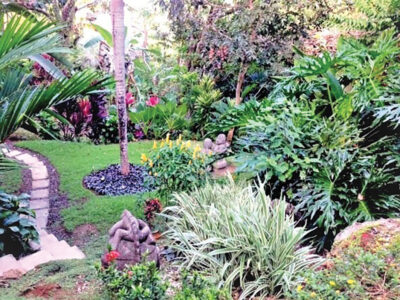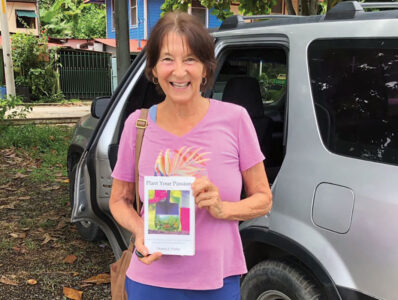IT’S A WONDERFUL WORLD OF PLANTS & GARDENS
 Back in May of 2009, new Owner/Publisher of Quepolandia, Pat Cheek, asked me if I would be interested in writing articles about plants for the magazine. Being a Horticulturist, as well as one who is rarely at a loss for words—especially when it comes to teaching people about plants and gardening—I was honored by the invitation and jumped on the opportunity. And so, began my monthly article, It’s a Wonderful World of Plants, which continued until September of 2012. It was a commitment that I took seriously. This was before the days of easy information access via the internet. I relied on my knowledge gained from 4 ½ years of schooling while acquiring a B.S. in Horticulture, decades of hands-on experience (including tropical gardening) and my personal library. I commenced by getting up on my soapbox with this excerpt:
Back in May of 2009, new Owner/Publisher of Quepolandia, Pat Cheek, asked me if I would be interested in writing articles about plants for the magazine. Being a Horticulturist, as well as one who is rarely at a loss for words—especially when it comes to teaching people about plants and gardening—I was honored by the invitation and jumped on the opportunity. And so, began my monthly article, It’s a Wonderful World of Plants, which continued until September of 2012. It was a commitment that I took seriously. This was before the days of easy information access via the internet. I relied on my knowledge gained from 4 ½ years of schooling while acquiring a B.S. in Horticulture, decades of hands-on experience (including tropical gardening) and my personal library. I commenced by getting up on my soapbox with this excerpt:
Plants are one of our most fascinating, precious and essential companions of our earth. They provide us with abundant benefits including: foods and beverages that sustain us, nourish us, elate us and tantalize our taste buds; medicines that soothe our aches and pains and cure our ailments and diseases; products that cleanse and beautify our bodies; materials for home construction, furniture and musical instruments; shade that cools us; filtered air to breathe; and an abundance of unsurpassed, never-ending beauty. They are a vital component of our earth’s magnificently intertwined biological system and without them humans and animals, simply, could not exist. So, celebrate, appreciate and cherish plants, because life as we know it could not continue on without them.
With an awareness that most Quepolandia readers hail from more northern, temperate climates, I realized that plants here in Costa Rica—specifically along the lowland tropical rainforests of the Central Pacific coast—were not what most folks were accustom to seeing or growing in outdoor landscapes. Actually, many plants seen in gardens here are grown as interior plants in northern parts of the world, and with the enormous size they can attain, you wonder if they are on steroids. Gardening, in general, is a whole new ballgame in the tropics. My articles covered various topics including tips on design, planting in containers, natives and exotics, maintenance techniques like watering, mulching, pruning and integrated pest management, plant uses and origins, soils, tropical ornamentals and fruits.
I was not just talking the talk, but walking the walk. My initial plan for my first business, Botanical Garden Excursions, S.A., was to offer private tours to various horticultural attractions and public gardens. But this quickly morphed into a landscape design, installation, and maintenance service for private residences and vacation homes in the area. Over the years, I created a total of sixteen gardens ranging from extensive projects at newly-constructed home sites, renovations, to the welcomed smaller, easier jobs. Training local “machete” gardeners (as I dubbed them) on proper pruning techniques (using appropriate tools), composting, and other ‘foreign’ more sustainable maintenance practices were also part of my services. My forte was—and I am still a stickler about—pruning trees correctly. I cringe—almost cry—when I see beautiful trees haphazardly butchered by machetes or chainsaws wielded by unskilled workers.
In 2005, I was fortunate to have been able to team up with Dr. Humberto Jimenez Saa, a Dendrologist (woody plant specialist) from the San Jose area. Together we developed botanical trails within the forests of the Tulemar property, identifying trees and shrubs with wooden signs, along with a printed guide booklet, complete with descriptions and plant photos. This was as exciting to me as Christmas is to a kid, and the idea evolved. Wooden labels, no matter how much maintenance applied, only lasted in this unforgiving climate for a maximum of 5 years. From prior projects I had done in the states, I was familiar with and began importing anodized aluminum plant labels, imprinted using a highly-specialized method with both scientific and common name and descriptions in both English and Spanish. These had a duration of twenty-five years with little maintenance. This endeavor helped to feed and satisfy my passion for teaching people about plants.
The labeling projects were a stroll through the park in comparison to garden installation jobs. I was never one to sit under a shade tree enjoying refreshments, dishing out orders, while my crews did all the grueling work. I slogged right along-side them doing the strenuous tasks, grimy, stinky, and sweating until every inch of me was soaked. That’s the only way a woman supervisor gains respect in this field. And today, in some strange way, I miss that butt-busting work, and the satisfying sensation of relaxing on my porch at day’s end after a refreshing shower, cold beverage in hand, physically exhausted, reflecting and contemplating on the work-in-progress or completed garden.
But the times changed and I decided to take a few alternate paths, but not straying too far from my passion for plants. I became fascinated with hemp, relocating back to the states in 2017 for a while to educate myself and start my next business HelloHemp, selling a select variety of quality hemp products, including CBD. But, thanks to a speedily-inundated market and COVID, I returned to Costa Rica in 2020, eventually switching gears into writing a book—a true story that has been caged inside of me and gnawing at the walls of my mind like a confined wild animal trying to get out.
 The final events of this aforementioned true story were what kicked me hard in the behind, prompting me to move to Costa Rica in 2003, all spurred from my effort of trying to make a difference in the world by starting the Botanical Garden of the Ozarks. A botanical garden? That sounds pretty flowery—right? Well, unfortunately, it wasn’t all roses and petunias. This imprisoned story flowed off of my fingertips and into written words at an unbelievable pace and within a year’s time, twenty-one chapters were completed and it was published. It seemed surreal.
The final events of this aforementioned true story were what kicked me hard in the behind, prompting me to move to Costa Rica in 2003, all spurred from my effort of trying to make a difference in the world by starting the Botanical Garden of the Ozarks. A botanical garden? That sounds pretty flowery—right? Well, unfortunately, it wasn’t all roses and petunias. This imprisoned story flowed off of my fingertips and into written words at an unbelievable pace and within a year’s time, twenty-one chapters were completed and it was published. It seemed surreal.
So, now that you have had a short overview of my history with the recently-turned-25-year-old Quepolandia (Bravo!) and my professional background here in the area, I would like to present my newly-published book—appropriately entitled—Plant Your Passion: Memoir of a Determined Woman’s Path into Horticulture, Botanical Gardens and Making a Difference. It daringly delves back into my past, portraying a reckless, independence-seeking adolescent, saved by horticulture, depicting the challenges, disappointments and the triumphs on that proverbial road less traveled. It conveys inspiring messages, takes you into the mysterious and on to adventures, and shares some valuable life lessons, especially for young adults. It may ring of familiar experiences or appeal to you as a garden and plant enthusiasts—highlighting eighteen public gardens—including Costa Rica’s Wilson Botanical Garden in San Vito de Coto Brus and Lankester Botanical Gardens in Cartago. It’s available on Amazon, Barnes & Noble, locally at Modern Primitive Living in Manuel Antonio or directly through me (signed of course). I hope you’ll give it a read, perhaps even write a review. A sequel is slowly underway.
Donna Porter was the founder and first Executive Director of the Botanical Garden of the Ozarks. She has resided in Costa Rica for the majority of the past 22 years. donnaeporter.com 6007-7779

